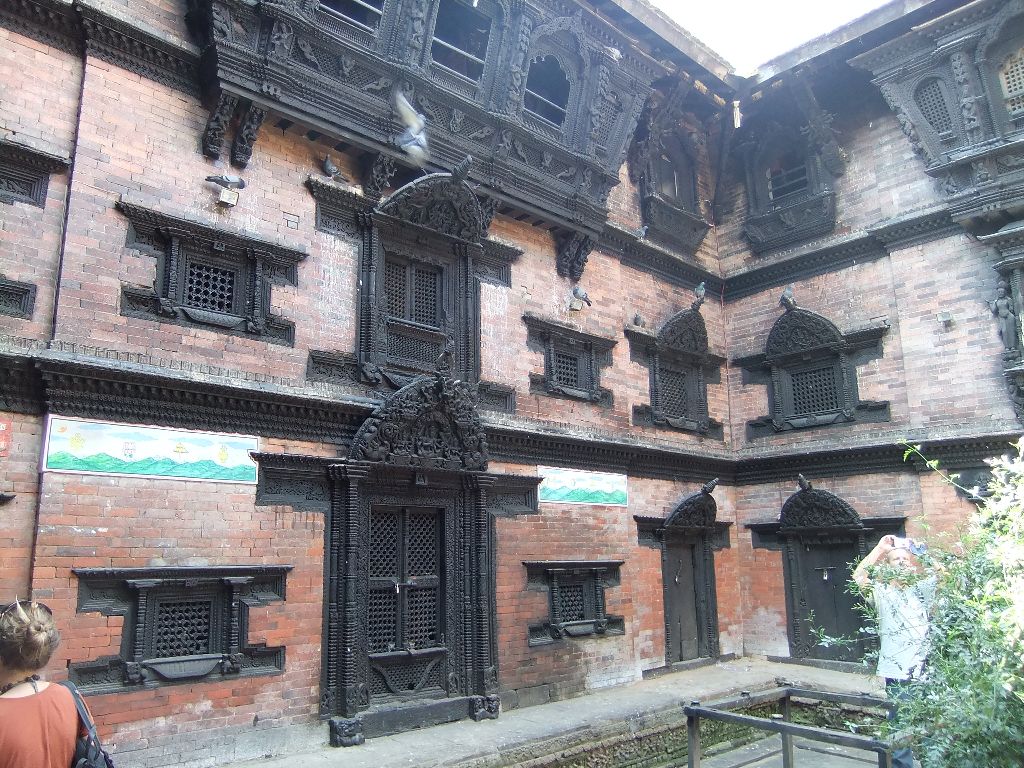
Kumari goddess (Source: Wikipedia)
On the 5th of October, 2010 I visited Kathmandu, the capital of Nepal, and watched the veneration of the Kumari Devi, a small girl, that Hindus and Buddhists worship as goddess. She has an appearance of a minute once a day at a barred window of the ‚Kumari Ghar Temple‘ standing in the center of the city opposite to the main palace. The Kumari Devi is the most important of the Kumaris, the term für young girls venerated as goddess. The Nepali King asked for the blessing by the Kumari Devis reguarly, since the Maoists took over 2008, even the Prime Minister asks for her blessing.
The best history and description of the tradition of the Kumari Devi coming from the 16th century, is a German book published in 2006, which speaks about her predecessor (Gerhard Haase-Hindenberg: Göttin auf Zeit. Amitas Kindheit als Kumari in Kathmandu. Heyne-Verlag, München 2006). The Wikipedia summarised the book as given below in the box in a shortened version – using the text of the day of my visit.

Temple of Kumari on the day of my visit. (Source: Schirrmacher)
I visited the temple together with Raju Thapa, director of the Nepali branch of the human rights organisation Human Rights Without Frontiers, who brought me up to date concerning the human rights situation in Nepal, but especially informed me about the law suit gong on since 2006, in how far the human rights and children´s rights of the Kumaris are violated, as the better known of them do not go to school, but live in one large room of the temple day and night (see news item about the court case: here, here and here). This question is connected to a research project of the International Institute for Religious Fredom (IIRF), in how far religious freedom has to be in balance with other human rights.
Further information:
„Kumari, or Kumari Devi, is the tradition of worshipping young pre-pubescent girls as manifestations of the divine female energy or devi in South Asian countries. Kumari literally means virgin in Sanskrit, Nepali and other Indian languages and is a name of the goddess Durga as a child. In Nepal a Kumari is a prepubescent girl selected from the Shakya clan of the Nepalese Newari community. The Kumari is revered and worshiped by some of the country’s Hindus as well as the Nepali Buddhists, though not the Tibetan Buddhists.
While there are several Kumaris throughout Nepal, with some cities having several, the best known is the Royal Kumari of Kathmandu, and she lives in the Kumari Ghar, a palace in the center of the city. The selection process for her is especially rigorous. The current Royal Kumari, Matina Shakya, aged four, was installed in October 2008 by the Maoist government that replaced the monarchy. …
A Kumari is believed to be the bodily incarnation of the goddess Taleju (the Nepalese name for Durga) until she menstruates, after which it is believed that the goddess vacates her body. Serious illness or a major loss of blood from an injury are also causes for her to revert to common status.
Once the chosen girl completes the Tantric purification rites and crosses from the temple on a white cloth to the Kumari Ghar to assume her throne, her life takes on an entirely new character. She will leave her palace only on ceremonial occasions. Her family will visit her rarely, and then only in a formal capacity. Her playmates will be drawn from a narrow pool of Newari children from her caste, usually the children of her caretakers. She will always be dressed in red, wear her hair in a topknot and have the agni chakchuu or ‚fire eye’ painted on her forehead as a symbol of her special powers of perception.
The Royal Kumari’s new life is vastly different from the one to which she has been accustomed in her short life. Whilst her life is now free of material troubles, she has ceremonial duties to carry out. The Kumari’s walk across the Durbar Square is the last time her feet will touch the ground until such time as the goddess departs from her body. From now on, when she ventures outside of her palace, she will be carried or transported in her golden palanquin. Her feet, like all of her, are now sacred. Petitioners will touch them, hoping to receive respite from troubles and illnesses.
The power of the Kumari is perceived to be so strong that even a glimpse of her is believed to bring good fortune. Crowds of people wait below the Kumari’s window in the Kumari Chowk, or courtyard, of her palace, hoping that she will pass by the latticed windows on the third floor and glance down at them. Even though her irregular appearances last only a few seconds, the atmosphere in the courtyard is charged with devotion and awe when they do occur.“
One Comment
Kann man bei einer Göttin denn überhaupt noch von Menschenrechten sprechen?